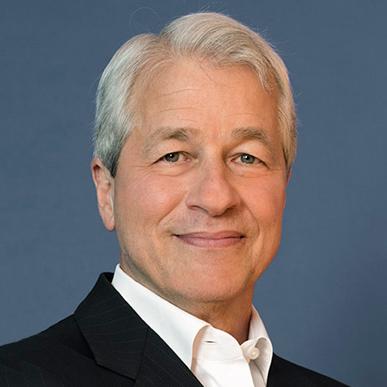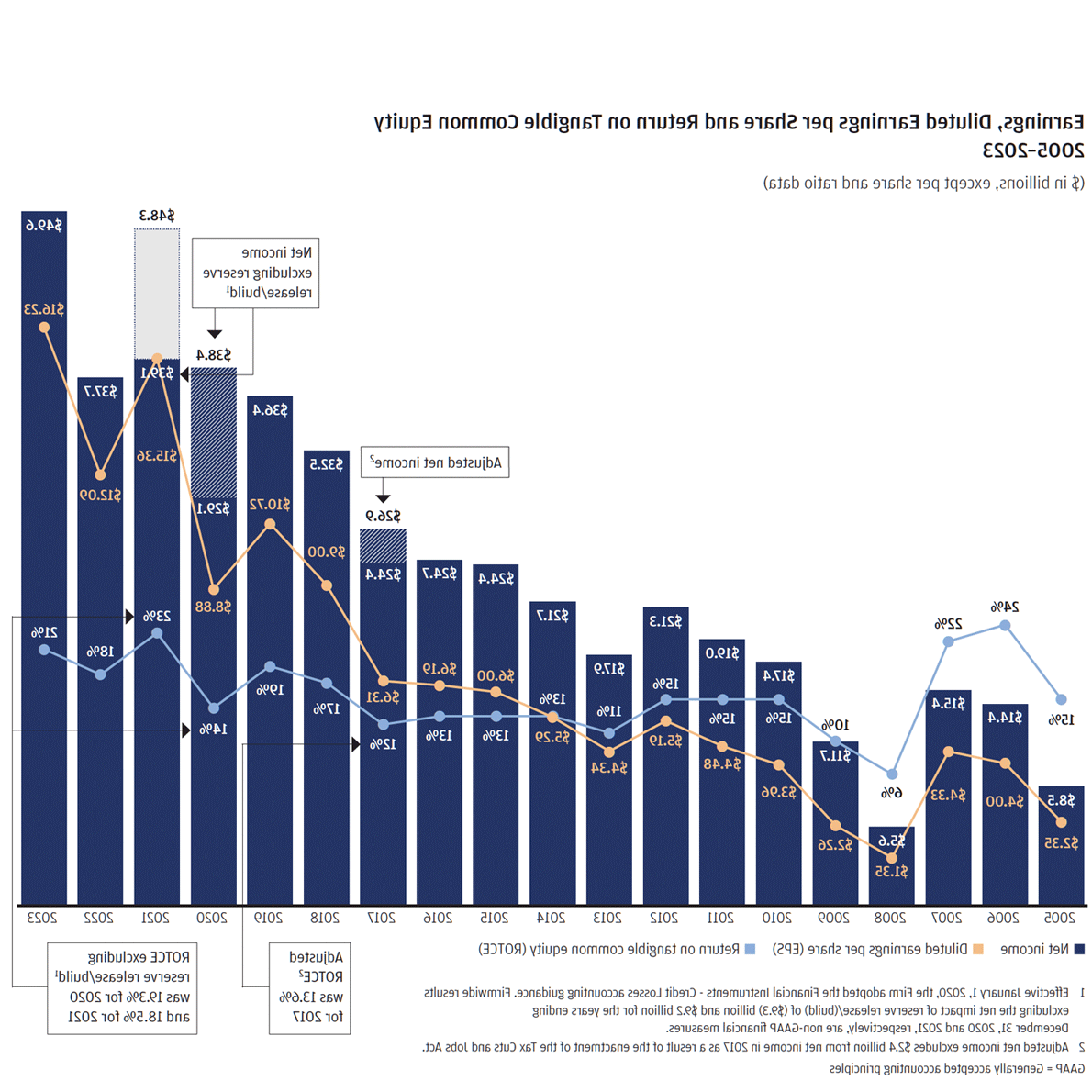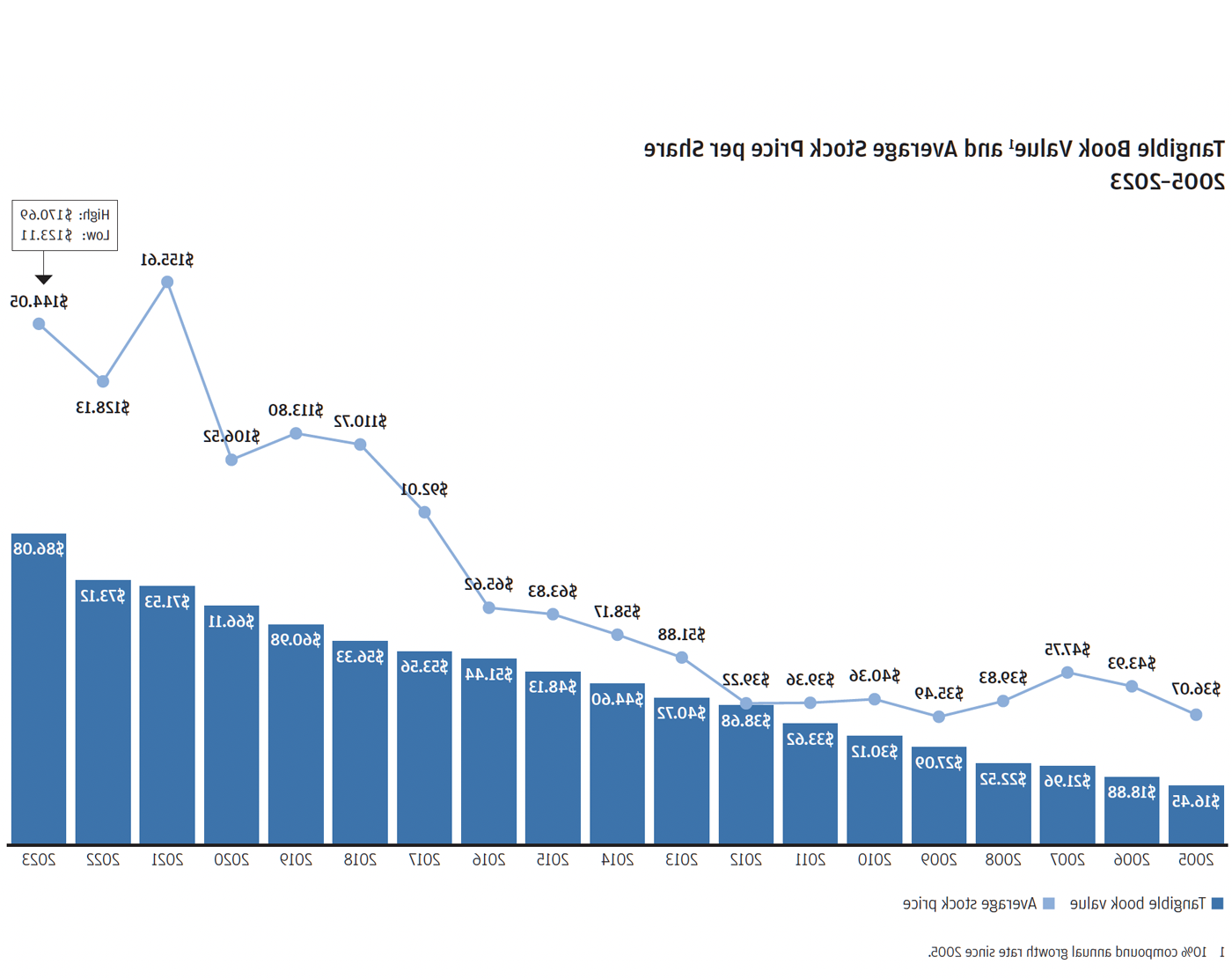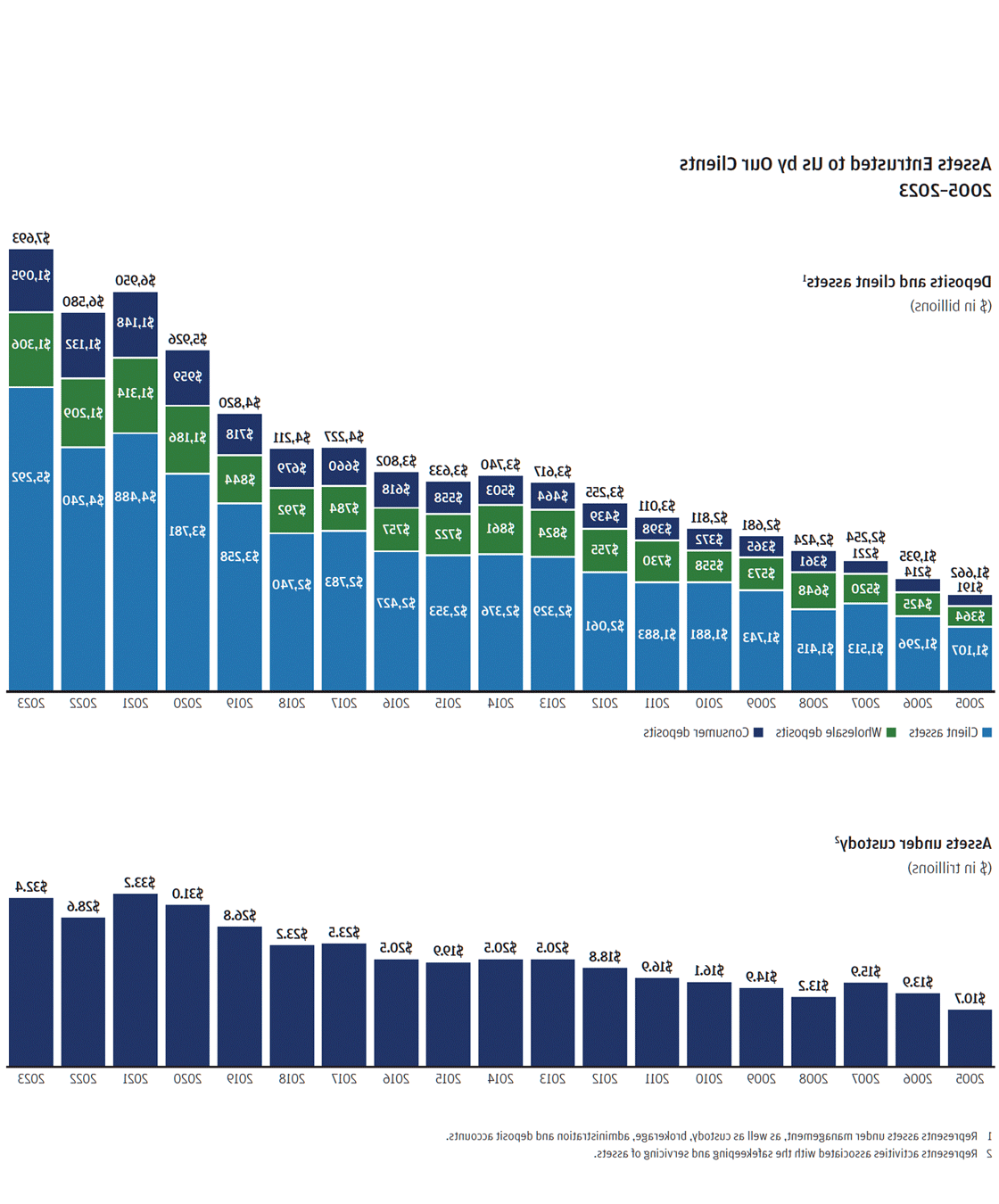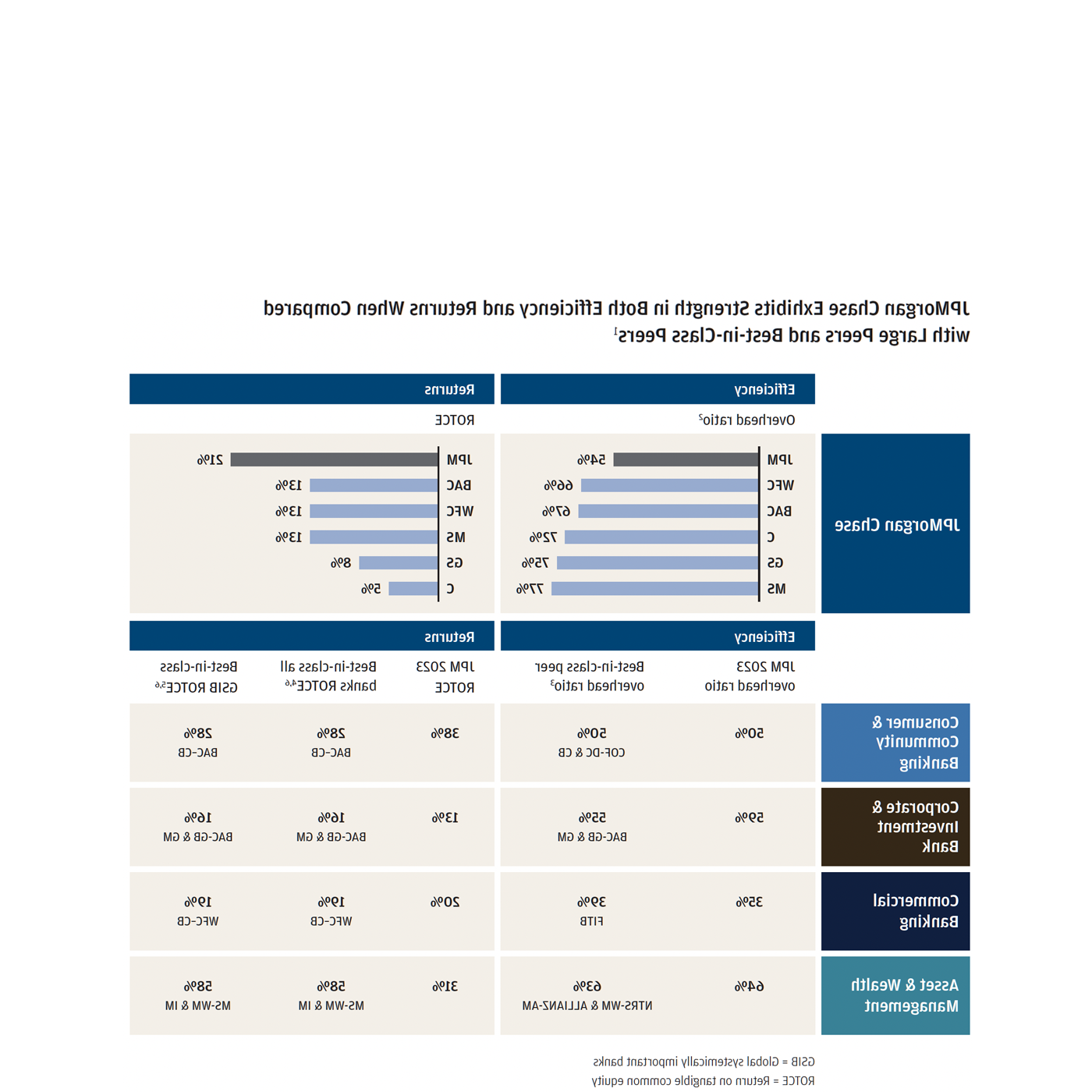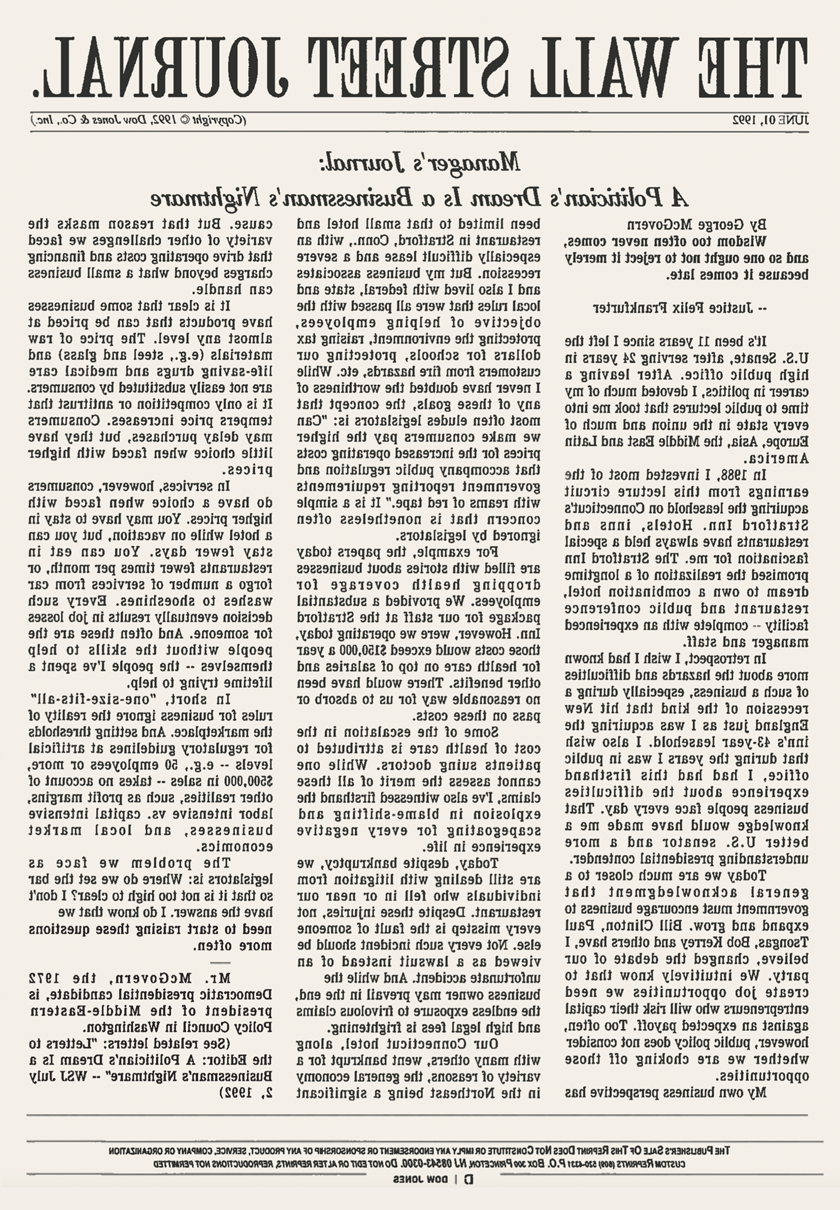In past years, I have written extensively about public policy issues. It is important to engage in these conversations, particularly around domestic economic policy because policy matters. While JPMorgan Chase can execute specific plans to improve outcomes for customers and communities, there is no replacement for effective government policies that add to the general well-being of the country. A stronger and more prosperous country will make us a stronger company.
As CEO of this company, every year I visit numerous countries around the globe. I meet with foreign government leaders, presidents and prime ministers, business leaders, and civic and academic experts, which allows me to learn a significant amount about how public policy is executed around the world. It also reinforces some of the critical values and virtues that are essential to a healthy country.
Every time I see the American flag, it reminds me of the values and virtues of this country and its founding principles conceived in liberty and dedicated to the notion that all men and women are created equal. Talk with someone who has recently become a naturalized citizen or watch a ceremony where groups of people take the oath to America, and you will see extraordinary joy and newfound pride. They now live free, with individual rights protected by the Constitution and with their life and the well-being of their family and community protected by the U.S. military. As Americans, we have much to be grateful for and much to defend.
If you read the newspaper from virtually any day of any year since World War II, there is abundant coverage on wars — hot and cold — inflation, recession, polarized politics, terrorist attacks, migration and starvation. As appalling as these events have been, the world was generally on a path to becoming stronger and safer. When terrible events happen, we tend to overestimate the effect they will have on the global economy. Recent events, however, may very well be creating risks that could eclipse anything since World War II — we should not take them lightly.
February 24, 2022 is another day in history that will live in infamy. On that day, 190,000 Russian soldiers invaded a free and democratic European country — importantly, somewhat protected by the threat of nuclear blackmail. Russia’s invasion of Ukraine and the subsequent abhorrent attack on Israel and ongoing violence in the Middle East should have punctured many assumptions about the direction of future safety and security, bringing us to this pivotal time in history. America and the free Western world can no longer maintain a false sense of security based on the illusion that dictatorships and oppressive nations won’t use their economic and military powers to advance their aims — particularly against what they perceive as weak, incompetent and disorganized Western democracies. In a troubled world, we are reminded that national security is and always will be paramount, even if its importance seems to recede in tranquil times.
The fallout from these events should also lay to rest the idea that America can stand alone. Of course, U.S. leaders must always put America first, but global peace and order are vital to American interests. Only America has the full capability to lead and coalesce the Western world, though we must do so respectfully and in partnership with our allies. Without cohesiveness and unity with our allies, autocratic forces will divide and conquer the bickering democracies. America needs to lead with its strengths — not only its military but also its economic, diplomatic and moral forces. And now we must do so as America’s leadership is being challenged around the world. There is nothing more important.
Policy and strategy matter, and it’s important to be engaged.
In our increasingly complex world, there is a vital interrelationship between domestic and foreign economic policy, particularly around trade, investment, national security and other issues. And, of course, while American voters and leadership set U.S. foreign policy, being a constructive part of the global conversation has become more important than ever.
If you doubt how important public policy is for the health of a country, you need to look no further than the recent history of Greece, Ireland or Singapore. Each of these countries, starting from deeply challenging places, implemented effective government and policies that have done a great job of lifting up their people when many thought it wasn’t possible. Sweden is another great example of a country with good broad-based policies that have succeeded at precisely what we all may want — a dynamic, innovative, free-market economy (Sweden actually has fewer government-owned enterprises than America) and safety nets that work. Conversely, you need to look no further than North Korea or Venezuela to see the complete destruction and havoc that terrible public policies (often in the name of the people) can cultivate.
Strategy by its nature must be comprehensive. In the rest of this section, I try to answer the question: What must we do to ensure that the world stays safe, not only for America but for freedom and democracy? A comprehensive strategy entails four important pillars, and we must succeed at each:
- Maintain American leadership (including military).
- Achieve long-term economic success with our allies.
- Strengthen our nation domestically.
- Deepen focus and resolve on addressing our most pressing challenges.
COALESCING THE WESTERN WORLD — A UNIQUELY AMERICAN TASK
Only America has the full capabilities of military might, economic power and the principles that most people around the world yearn for — based on “liberty and justice for all” and the proposition that all people are created equal. America remains the bastion of freedom and the arsenal of democracy.
There is no alternative to American leadership.
In the free and democratic Western world, and, in fact, for many other countries, there is no real or good alternative to America. The only other potential superpower is China. Other nations know they can rely on the founding principles of America. If we reach out our hand, most nations will happily take that hand. America is still the most prosperous nation on the planet, which not only can guarantee our military strength but also positions us to help our allies develop and grow their nations (though we should minimize the “our way or the highway” type of behavior). This leadership is needed today to help Ukraine stay free in its battle with Russia.
Most of the world wants American leadership.
America continues to be the envy of much of the world, and as we’ve seen with the challenges at our borders, there is a reason people want to come here and not to autocratic nations. If you opened America’s borders to the rest of the world, I have little doubt that hundreds of millions of people would want to move here. By contrast, not many would want to emigrate to autocratic nations. Also, I have little doubt that if most investors across the globe could only invest in one country, they would choose the United States. Beyond our country’s borders, people and nations around the world understand the role that America has played in promoting world peace — known as Pax Americana. For the most part, Pax Americana has kept the world relatively peaceful since World War II and helped lead to enormous global economic prosperity, which has helped lift 1.3 billion people out of poverty.
Modern America does not engage in economic coercion or foreign wars to steal land or treasure. The fact that some of our foreign excursions might have been misguided does not negate this. We helped rebuild Europe and Japan after the devastation of World War II, and we, with our allies, have helped create global institutions to maintain peace. We are still trusted.
First and foremost, the Western world needs unquestioned military might — peace through strength.
“We know only too well that war comes not when the forces of freedom are strong, but when they are weak,” said Ronald Reagan in 1980.
So far, the Western world has done a good job in strengthening military alliances in response to the war in Ukraine. Ukraine is essentially the front line that needs immediate support. Providing that support is the best way to counter autocratic forces that would seek to weaken the Western world, particularly America. But the ongoing wars in Ukraine and the Middle East could become far worse and spread in unpredictable ways. Most important, the specter of nuclear weapons — probably still the greatest threat to mankind — hovers as the ultimate decider, which should strike deep fear in all our hearts. The best protection starts with an unyielding resolve to do whatever we need to do to maintain the strongest military on the planet — a commitment that is well within our economic capability.
American leadership requires not only the military but also the full “symphony of power.”
Former Secretary of Defense Robert Gates, in his book Exercise of Power, writes extensively in the first chapter about “the symphony of power.” He makes the critical point that America has often overused and misused military power and has massively underused other muscles — diplomacy, intelligence, communication (explaining to the world the benefits of democracy and free enterprise) and comprehensive economic policy.
America has the most extensive group of partners, friends and allies — both military and economic — that the world has probably ever seen. We should put this to better use.
The American public ought to hear more about why this is so important.
International isolationism has run through American foreign policy throughout our history, frequently with good reason. The chant, “Don’t get involved in foreign wars” was often right. That said, the American public should remember that even after the Revolutionary War, we did, in fact, have British and French armies on our soil. The sinking of American merchant and passenger ships during World War I and the surprise attack on Pearl Harbor in World War II brought isolationism to a close for a time. America is never far from being dragged into terrible conflicts. Global wars come to our shores whether we like it or not — we need to stay engaged.
In perilous periods of history when our allies and other democracies were under serious assault, great American leaders have inspired the American people — through words and actions — to stand up to help and defend them. Staying on the sidelines during battles of autocracy and democracy, between dictatorship and freedom, is simply not an option for America today. Ukraine is the front line of democracy. If the war goes badly for Ukraine, you may see the splintering of Pax Americana, which would be a disaster for the whole free world. Ukraine’s struggle is our struggle, and ensuring their victory is ensuring America first. It is imperative that our national leaders explain to the American people what is at stake and make a powerful case – with energy, consistency and clarity – for our strong enduring commitment to Ukraine’s survival for as long as it takes (and it could take years).
One last point: Ukraine needs our help immediately, but it’s important to understand that much of the money that America is directing to Ukraine is for purchasing weapons and equipment, most of which will be built in America. Not only is our aid helping Ukraine, but it is going directly to American manufacturers, and it is helping the country rebuild our military industrial capacity for the next generation.
STRENGTHENING OUR POSITION WITH A COMPREHENSIVE, GLOBAL ECONOMIC SECURITY STRATEGY
Sustaining America’s economic strength is a bedrock for our long-term military strength. There are many things we need to do to strengthen the U.S. economy, and I talk about that later in this section. This discussion is about foreign economic policies – the economic battlefield.
The whole Western world is rethinking and reimagining its military strategies and alliances. We need to do the same for our economic strategies and alliances, but we should be guided by a comprehensive global strategy that deals with critical issues. Done properly, such a strategy would help strengthen, coalesce and possibly be the glue that holds together Western democratic alliances over decades.
Foreign economic policy involves trade and investment, export controls, secure and resilient supply chains, and the execution of sanctions and any related industrial policies. It must also include development finance — think of the “Belt and Road” efforts in China — which are critical to most developing nations. This framework should tell us not only how to deal with our allies but also how to work with nonaligned nations around the world. These strategies should not be aimed against any one country (such as China) but rather be focused on keeping the world safe for democracy and free enterprise.
Economic national security is paramount — both for the United States and for our allies.
It is a valid point that the Western world — both government and business — essentially underestimated the growing strength and potential threat of China. It’s also true that China has been comprehensively and strategically focused on these economic issues, all while we slept. But let’s not cry over spilled milk — let’s just fix it.
We missed the potential threat from three vantage points. The first is companies’ overreliance on China as the sole link in their supply chain, which can create vulnerabilities and reduces resiliency. But to the extent this involves everyday items, like clothes, sneakers, vaccine compounds and consumer goods, this dependency is not as critical or complex and will eventually be sorted out.
The second is the most critical. The United States cannot rely on any potential adversaries for materials essential to our national security — think rare earths, 5G and semiconductors, penicillin and materials critical to essential pharmaceuticals, among others. We also cannot be sharing vital technologies that can enhance an adversary’s military capabilities. The United States should properly and narrowly define these issues and then act unilaterally, if necessary, to fix them.
The third is also complex, which is countering unfair competition or “mercantilist” behavior in critical industries; think electric vehicles, renewable energy and AI, among others. Examples of this would be where a state, any state, uses government powers, capital, subsidies or other means to dominate critical industries and deeply damage the economic position of other nations. Weakening a country economically can render it a virtual “vassal state,” reliant on potential adversaries for essential goods and services, which also weakens it militarily. We cannot cede our important resources and capabilities to potential adversaries.
All these issues can be resolved, though they will take time and need devoted effort.
Every nation will have different national security issues. For example, Europe in general and countries like India, Japan and Korea need reliable, affordable and secure energy; many nations would put food security as their top concern. This means that we must work with our allies to accomplish our own goals and to help them accomplish theirs. We have extraordinary common interests in our joint security: We must hang together — because if we don’t, we will assuredly hang separately.
We already engage in trade — improving it is good economics and great geopolitics.
We must have a better understanding of trade. As a nation, we refuse to get into genuine trade discussions, but this ignores the complete and obvious truth — we already have trade relationships with all these countries. Approximately 92% of the world’s consumers live outside the United States. Increased trade allows our workers and farmers to access those markets. We should negotiate trade agreements that can achieve more, economically, for ourselves and our allies, as well as meet all of our national security needs. While it is appropriate to use trade to continue to nudge allies in the right direction around human rights and climate, this objective should be subordinated to our national interests of long-term security.
Negotiating must be done in concert with our allied nations so as not to cause a fissure in economic relations. This is critical — strong economic bonds will help ensure strong military alliances. The Inflation Reduction Act has much good in it (more on this later), but it angered many of our allies. To them, the bill was by America and for America, and, subsequently, they felt a need to match it so their businesses would not be disadvantaged. The terms of the legislation could have been better negotiated with our allies in mind, strengthening our economic ties with the free world.
We should also immediately re-enter, if possible, the prior negotiated Trans-Pacific Partnership agreement. Not only is it good for the economy, but it also could be a brilliant, strategic, economic security move — an economic alliance that binds us with 11 other important countries (including Australia, Chile, Japan, Malaysia, Mexico, Singapore and Vietnam). Geopolitically and strategically, this might be one of the most important moves to counter China. While this is a challenging step, our political leaders need to explain and lead — and not be afraid of dealing with the tough issues. We also need to acknowledge that there have been real negative job impacts as a result of trade, which are usually concentrated around certain areas and businesses. So any new trade policy should be combined with a greatly enhanced Trade Adjustment Assistance program, which provides retraining, income assistance and relocation for those workers directly impacted by trade.
Trade is realpolitik, and the recent cancellation of future liquified natural gas (LNG) projects is a good example of this fact. The projects were delayed mainly for political reasons — to pacify those who believe that gas is bad and that oil and gas projects should simply be stopped. This is not only wrong but also enormously naïve. One of the best ways to reduce CO2 for the next few decades is to use gas to replace coal. When oil and gas prices skyrocketed last winter, nations around the world — wealthy and very climate-conscious nations like France, Germany and the Netherlands, as well as lower-income nations like Indonesia, the Philippines and Vietnam that could not afford the higher cost — started to turn back to their coal plants. This highlights the importance of safe, secure and affordable energy. Second, the export of LNG is a great economic boon for the United States. But most important is the realpolitik goal: Our allied nations that need secure and affordable energy resources, including critical nations like Japan, Korea and most of our European allies, would like to be able to depend on the United States for energy. This now puts them in a difficult position — they may have to look elsewhere for such supplies, turning to Iran, Qatar, the United Arab Emirates or maybe even Russia. We need to minimize anything that can tear at our economic bonds with our allies.
The strength of our domestic production of energy gives us a “power advantage” — cheaper and more reliable energy, which creates economic and geopolitical advantages.
Industrial policy is now necessary, but it should be carefully constructed and limited.
In some cases, industrial policy (using government resources to subsidize investments to help make businesses more competitive) may be the only solution for quickly building up the industries we need (rare earths and semiconductors, among others) to guarantee resilient national security. The IRA and CHIPS Act are good examples of this and government has to get it right.
Such policy can also be used to help combat unfair competitive policies of nations that are using state capitalism and state control to dominate critical industries. However, when crafting industrial policy, the function of government needs to be narrowly defined and kept simple; i.e., governmental jurisdiction should be limited to very specific products and probably to what we know works, such as tax credits and, to a lesser extent, loan guarantees. And industrial policy should include twin provisions: 1) strict limitations on political interference, like social policies, and 2) specific permitting requirements, which, if not drastically improved, will badly inhibit our ability to make investments and allow infrastructure to be built. Adding social policy, politics and matters other than simple tax credits dramatically reduces the economic efficiency of industrial policy and creates conditions for corporate America to feed at the trough of government largess. We should quickly address how we can improve on already executed legislation. We do not want to look back and have great regrets about how so much of this policy work failed.
There are those who argue that the U.S. government needs much more far-reaching industrial policy to be able to micromanage and accomplish its many ambitious objectives. To those I say, read further in this section about how ineffective so many government policies have been.
We should be tough, but we should engage with China.
Over the last 20 years, China has been executing a more comprehensive economic strategy than we have. The country’s leaders have successfully grown their nation and, depending on how you measure it, have the first or second largest economy in the world. That said, many question the current economic focus of China’s leadership as they don’t have everything figured out. While China has become the largest trading partner to many countries around the world, its own GDP per person is $13,000. And the country continues to be beset by many economic and domestic issues.
China has its own national security concerns. The country is located in a very politically complex part of the world, and many of China’s actions have caused its neighbors (e.g., Japan, Korea, Philippines, among others) to start to re-arm and, in fact, draw closer to the United States. It also surprises many Americans to hear that while our country is 100% energy sufficient, China needs to import 10 million barrels of oil a day. It is clear that China’s new leadership has set a different course, with a much more intense focus on national security, military capability and internal development. That is their right, and we simply need to adjust to it.
America still has an enormously strong hand — plenty of food, water and energy; peaceful neighbors; and what remains the most prosperous and dynamic economy the world has ever seen, with a per person GDP of over $80,000 a year. Most important, our nation is blessed with the benefit of true freedom and liberty. See the sidebar on the amazing power of freedom later in this section.
While we may always have a complex relationship with China (made all the more complicated and serious by ongoing wars), the country’s vast size and importance to so many other nations requires us to stay engaged — thoughtfully and without fear. At the same time, we need to build and execute our own long-term, comprehensive economic security strategy to keep our position safe and secure. I believe that respectful, strong and consistent engagement would be best for both our countries and the rest of the world.
We need to strengthen and rebuild the international order — we may need a new Bretton Woods.
The international rules-based order established by the Western world after World War II is clearly under attack by outside forces, somewhat weakened by its own failures and inability to keep up with the increasingly complex world. This international order relies on a web of military alliances, trade agreements (e.g., World Trade Organization), development finance (e.g., International Monetary Fund and the World Bank) and related global tax and investment policies and diplomacy organizations (e.g., United Nations), which have evolved into a confusing and overlapping regime of policies. You can now add to it the new issues of cyber warfare, digital trade and privacy, and global taxes, among others.
It might be a good idea to convene a group of like-minded leaders to build and improve upon what already exists. The time may be right for a reimagined Bretton Woods — and by this, I mean revitalizing our global architecture. Since too many parts of the world have been neglected, any new system has to take into account and properly address the needs of all nations, including areas of concentrated poverty.
While we hope the wars in Ukraine and in the Middle East will end eventually (and, we hope, successfully from the standpoint of our allies), these other critical economic battles could possibly continue throughout our lifetime. If the Western world is slowly split apart over the next few decades, it will likely be the result of our failure to effectively address crucial global economic challenges.
PROVIDING STRONG LEADERSHIP GLOBALLY AND EFFECTIVE POLICY MAKING DOMESTICALLY
When you travel around the United States and talk with people of all types and persuasions, there is a rather common refrain; namely, why are we helping foreign nations with the safety of their borders and economies when we are not doing a particularly good job of protecting our own? While there is no moral equivalency in these arguments, they are understandable. It is clear that many Americans feel we need to do a better job here at home before we can focus over there. We can understand why some people living in this country, who have been neglected for decades, ask how their government can find the money for Ukraine and other parts of the world but not for them. It is a reasonable question.
From my point of view, our highly charged, emotional and political domestic issues are centered around 1) immigration and lack of border security and 2) the fraying of the American dream, particularly for low-income and rural Americans who feel left behind amid the growing wealth and prosperity of others around them. Please read the sidebar below, which I believe explains the legitimate frustration of some of our citizens. And I agree with them.
In the sidebar, I also explain how two policies (a large expansion of the Earned Income Tax Credit and focus on work skills and job outcomes at high schools, community colleges and colleges) would not only dramatically increase both the income and employment opportunities for many of those left behind but would also have the virtue of actually growing the workforce. The combined effect of all of this would be quite a boon to our GDP.
I believe that many affected Americans are not angry at hardworking, law-abiding immigrants and, in fact, acknowledge the critical role immigrants continue to play in building this wonderful country. Rather, they are angry that America has not implemented proper border control and immigration policies. It is astounding that many in Congress know what to do and want to do it but are simply unable to pass legislation because of partisan politics. Congress did come close on a few occasions — and I hope they keep trying.
Deliberate policies meant to drive healthy growth are needed.
For over two decades, since 2000, America has grown at an anemic rate of 2%. We should have strived for and achieved 3% growth. Had we done so, GDP per person today would be $16,000 higher, which would, in turn, have paid for better healthcare, childcare, education and other services. Importantly, the best way to handle our excess deficit and debt issues is to maximize economic growth.
Growth policies include (the list could be very long so I’ll just mention a few):
- Consistent tax policies, conducive to both employment and capital investment. Capital investment is the primary driver of innovation, productivity and, therefore, growth in America. Tax policies change too frequently, which causes uncertainty and complicates long-term capital investment decision making (I won’t bore you with the details here). A bipartisan committee of Congress is probably required to fix this — and the sooner the better.
- Well-conceived regulations (and related laws). This requires an ongoing concerted effort to streamline regulations to cost-effectively drive better outcomes for the United States. The last thing we need is a constant pile-on of politically driven, fragmented policies. Please read the sidebar, an editorial in The Wall Street Journal by George McGovern, one of the most liberal presidential nominees in our lifetime, in which he clearly lays out the complexity, risks and costs that businesses, large and small, face every day. While he acknowledges the worthiness of the goals of many regulations, he points out their negatives. He also calls out the “blame-shifting and scapegoating" and "the endless exposure to frivolous claims and high legal fees.” Not only is this state of affairs demoralizing, but it also reduces employment, capital investment and the formation of new businesses, as well as cause unnecessary bankruptcies. Estimates of the regulatory costs for America are approximately $19,000 per worker, dwarfing the regulatory burdens in other countries. We all want sensible regulations that make us a better and safer nation – but this number is astounding. We should be able to accomplish our goals while sharply reducing needless and wasteful expenses. And remember, it’s discouraging not only to companies but to all citizens who have to deal with it on a daily basis.





